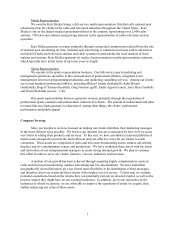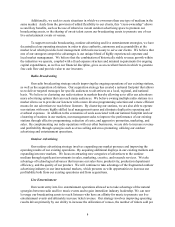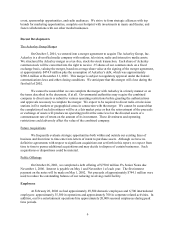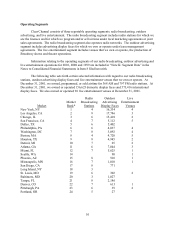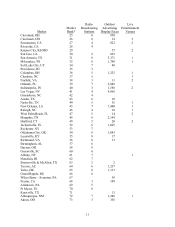iHeartMedia 2001 Annual Report Download - page 17
Download and view the complete annual report
Please find page 17 of the 2001 iHeartMedia annual report below. You can navigate through the pages in the report by either clicking on the pages listed below, or by using the keyword search tool below to find specific information within the annual report. 17
the stations’ service contours do overlap. Furthermore, a company may own two television stations in a
DMA with overlapping Grade B contours if (i) at least eight independently owned and operating full-
power television stations, the Grade B contours of which overlap with that of at least one of the
commonly owned stations, will remain in the DMA after the combination; and (ii) at least one of the
commonly owned stations is not among the top four stations in the market in terms of audience share.
The FCC will presumptively waive these criteria and allow the acquisition of a second same-market
television station where the station being acquired is shown to be “failed” or “failing” (under specific
FCC definitions of those terms), or authorized but unbuilt. A buyer seeking such a waiver must also
demonstrate, in most cases, that it is the only buyer ready, willing, and able to operate the station, and
that sale to an out-of-market buyer would result in an artificially depressed price. Since the revision of
the local television ownership rule, we have acquired a second television station in each of five DMAs
where we previously owned a television station.
The FCC has adopted rules with respect to so-called local marketing agreements, or “LMAs”, by
which the licensee of one radio or television station provides substantially all the programming for
another licensee’s station in the same market and sells all of the advertising within that programming.
Under these rules, an entity that owns one or more radio or television stations in a market and programs
more than 15% of the broadcast time on another station in the same service (radio or television) in the
same market pursuant to an LMA is required, under certain circumstances, to count the LMA station
toward its local radio or television ownership limits, as applicable, even though it does not own the
station. As a result, in a market where we own one or more radio or television stations, we generally
cannot provide programming under an LMA to another station in the same service (radio or television) if
we cannot acquire that station under the rules governing local radio or television ownership, as
applicable.
In adopting its rules concerning television LMAs, however, the FCC provided “grandfathering”
relief for LMAs that were in effect at the time of the rule change in August 1999. Television LMAs that
were in place at the time of the new rules and were entered into before November 5, 1996, were allowed
to continue at least through 2004, when the FCC is scheduled to undertake a comprehensive review and
re-evaluation of its broadcast ownership rules. Such LMAs entered into after November 5, 1996 were
allowed to continue until August 5, 2001 at which point they were required to be terminated unless they
complied with the revised local television ownership rule.
We provide programming under LMAs to television stations in two markets where we also own a
television station. In one additional market, a third party which owns a television station in that market
also programs our station under an LMA (we have agreed to sell our television station in that market to
the third-party programmer). Each of our television LMAs was entered into before November 5, 1996.
Therefore, under the FCC’s August 1999 decision, each of our television LMAs is permitted to continue
through at least the year 2004. Moreover, we may seek permanent grandfathering of our television LMAs
by demonstrating to the FCC, among other things, the public interest benefits the LMAs have produced
and the extent to which the LMAs have enabled the stations involved to convert to digital operation.
A number of cross-ownership rules pertain to licensees of television and radio stations. FCC
rules, the Communications Act or both generally prohibit an individual or entity from having an
attributable interest in both a television station and a cable television system that is located in the same
market, and from having an attributable interest in a radio or television station and a daily newspaper
located in the same market.


